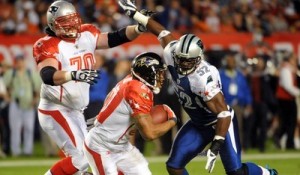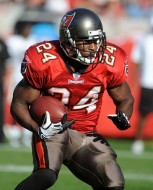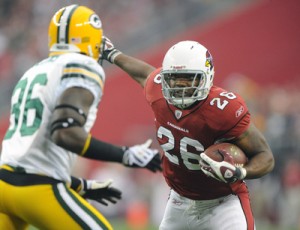NFL Fantasy Football Preview
By Kory Kepner on July 15, 2010 [/media-credit]
[/media-credit]Ray Rice should be high on your draft chart.
Hello and welcome to the first edition of Rocket Sports & Entertainment, Fantasy Football Edition. Hopefully this insight will help guide you to that pot of gold at the end of the season. No one can promise a championship as too much luck is involved, but some good advice and some thoughtful insight can go a long way.
First, a little on our fantasy background; we’ve been in competitive leagues going on two decades now, back to the days when the Monday paper was a bible because all the internet hosting sites didn’t yet exist. We both win and lose our fair share. People who tell you they always win are blowing smoke. Kory usually does about a dozen leagues a year, while Matt does considerably fewer as he relies on more mock drafts to gather his info. Needless to say, we’ve both seen many an oddity and weirdness when it comes to fantasy drafts. We’ve both been in the same ultra competitive league for a about a decade now; it’s not a league for the meek… one of us is the returning champ, but for the sake of Kory’s pride, we won’t say who that is.
Preparing for a fantasy football draft is not as simple as picking up a magazine with player rankings and picking the “best available” remaining player. There are lots of ways to gain an advantage over your opponents. We’d like to help you gain that edge.
Let’s start with the obligatory dos and don’ts of fantasy. Some call this the Fantasy Bible, Manifesto, Fantasy 101, etc. We call it mere common sense for anyone who wants to be competitive. Some of these will be overly familiar, some a little less obvious.
Here is what we use as standard scoring. In a Points Per Reception (PPR) you would get one point per reception.
• 1 point for 25 passing yards
• 1 point for 10 rushing yards
• 1 point for 10 receiving yards
• 6 points for a touchdown
• 4 points for a passing touchdown
• -2 points for every interception thrown or fumble lost
• 1 point for each extra point made
• 3 points for each 0-39 yard field goal, 4 points for each 40-49 yard field goal, and 5 points for each 50+ yard field goal
• 2 points per turnover gained by defense
• 1 points per sack by the defense
• 2 points for a safety by defense
• 6 points for each touchdown scored by defense
1. Know your league’s scoring rules better than everyone else. One of the most common mistakes is when people go into a draft thinking the league is a standard points and yardage league only to find out it’s a PPR league or the commissioner added some ridiculous stat, changed stat’s values, or starts three quarterbacks. These are some of the most common switches in competitive leagues and can greatly alter a player’s value. In a PPR league, Reggie Bush and his usually high reception totals shoot up the rankings while Michael Turner and his single digit receptions fall. As an example, here are last year’s standard totals for three of this year’s top four average picks.
Standard Points PPR Points
RB A 277 320
RB B 268 325
RB C 248 326
 [/media-credit]
[/media-credit]With the Bucs strong offensive line, Cadillac Williams may surprise some
So as you can see, RB C shouldn’t even be in the conversation for a standard league, but he would be the top pick in the PPR league. RB A is Adrian Peterson, B is Maurice Jones-Drew, and C is Ray Rice. Chris Johnson was left out because he just killed it last year. With 78 receptions last season, Rice’s value skyrocketed. There were only 18 WRs that caught more balls than he did.
Another common league variation is the value of passing TDs. Standard is four points, but some leagues up it to six. You’ll hear some “experts” say this makes a huge difference and should drastically elevate QBs in your draft. We don’t think so. Last year, there were 10 gunslingers that threw for 4000-plus yards and 26-plus TDs. To simplify that, with the stat change from four to six points the difference between the top QB and the 10th QB is 16 points, or a point a week. Meanwhile, only six running backs eclipsed the 300-carry mark. Four years ago that number was at 10. So who cares? Let some other owner overdraft his QB while you get a number one RB or WR.
We wouldn’t advise getting in a league that has outlandish settings or a ridiculous number of positions like the three QBs, as there simply aren’t enough to go around. These leagues are usually set up by commissioners who have no clue or are just cheaters and want to win an easy title. Most people quit from these leagues anyway. Where is the fun in that?
2. Separate your players into tiers or brackets. For the quarterbacks’ top tier, you have the cream of the fantasy crop: Rogers, Brees and Manning. After that you have about seven others who are all going to give about the same output, but with a significant drop off from these first three. Do this for every position. If you are determined to pick between two positions, then take the player you put in the higher tier as they will more than likely give you a better Points Average Against your Competition, or PAAC. PAAC is what makes these tiers important. It’s what each respective position on your team scores in comparison to your opponent’s playing-position score. If you get a tier one QB who averages 25 points a game and other team’s tier-two QB, who averages 20 points, you are already up five. So if you pass on tier-one players in order to take a second or third running back. you are giving up points that will probably be equal anyway. For example, Dallas Clark averaged 11PPG last year, outdistancing other TEs by a mile and outscoring most other TEs by five-six points a game. So try and get an elite first-tier player at every position rather than a second- or third- tier player in a more glamorous position. If running back A, B, and C all average 10 points a game and TE A averages 11 points a game while TEs B and C average 5, take TE A, as a comparable RB will be there later while the TE will not.
3. Know the NFL schedule for your fantasy playoffs, especially weeks 14-16. This is because you want players going against soft defenses when it’s “win or go home” time. A perfect example this year comes with Frank Gore and Stephen Jackson. Say you wind up with that middle of the first round pick, and you are stuck between these two. In week 16 (most leagues’ Championship week) they play against each other. Would you rather have Jackson against a SF defense that gave up 97 RYPG last year or Gore against a St. Louis defense that gave up 137 RYPG last year? Your tough decision just became very easy. Remember it’s not about going 14-0. It’s about getting into the playoffs and winning the last game.
4. Do not get caught at the end of a position run. There are three or four elite tight ends. If you are at the beginning of this run then grab one. If you don’t get one of the first-tier TEs don’t just take one of the second tier guys. Grab what you need because the next seven TEs are all the same caliber guy anyway and can be acquired a few rounds later.
5. During the draft, pay attention to and keep track of what the other teams in your league need. If you have the eighth pick and are torn between a WR and QB it helps to know what teams 9 and 10 have on their roster. If they both already have a QB, you should take the WR because odds are neither of them will take that QB you’re looking at because they already have one. It may mean you have to consume a few less adult beverages while drafting, but when you get to torment the other people in your league for the next year, you’ll realize it’s well worth it.
6. It’s okay to pick up a case of beer on the way to the draft–just not for you. Encourage others to indulge so that an hour and a half into the draft they start making weird picks because they are ‘outthinking’ everyone. Also, it’s okay to be the human-rain delay. Yes, it ticks people off–mainly Kory–but beer can throw people off their game plan and force them into stupid picks.
7. Stay current and informed. On that note… don’t be the guy that picks up a month’s old fantasy magazine on your way to the draft. You know, the one who starts looking at that magazine once on the clock and then takes a player who had been picked four rounds earlier or who is already injured and out for the season. You are there to pick a winner, not to catch up with the guy sitting next to you.
8. Mock it up! Enough can’t be said about knowing who is going when. The best way to track that is by doing as many mock drafts as you can. For instance, if you are big on, say, T.J. Houshmandzadeh this year, know in what round he is typically being picked. That way you can be a step ahead of the other managers in your league. That, in combination with knowing who your opponent has and what he needs, can be what earns you that golden ticket.
 [/media-credit]
[/media-credit]Beanie Wells should have a good year in the Valley of the Sun.
Photo By: PR Photo
9. Know what teams have the best offensive lines. It’s vital not only to how well a running back will perform, but also how safe your starting QB will be for the duration of the season. If he isn’t able to stay on his feet or in the pocket, then he’s not likely going to be throwing a lot of touchdown passes.
10. The most important rule: Never, never, never select a kicker before your last pick. NEVER! (Remember also to have fun. Why else would you play?)
Tags: Fantasy Football





 Tweet This
Tweet This Share on Facebook
Share on Facebook Digg This
Digg This Bookmark
Bookmark Stumble
Stumble





0 Comments
You can be the first one to leave a comment.